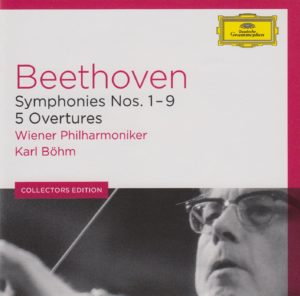 This morning’s “office” is Panera Bread, the restaurant chain that I have a dislike-hate relationship with. If Panera weren’t the only game in town at 6am (when I like to get started), I’d go somewhere else.
This morning’s “office” is Panera Bread, the restaurant chain that I have a dislike-hate relationship with. If Panera weren’t the only game in town at 6am (when I like to get started), I’d go somewhere else.
I first encountered Austrian conductor Karl Bohm (1894-1981) on Day 5. This morning, as then, he works with the Wiener Philharmonker (the Vienna Philharmonic Orchestra).
The music is Beethoven’s Symphony No. 2 in D Major, a piece of music to which I have as yet failed to warm up. It’s not Beethoven’s First, I can tell you that.
The label is the revered Deutsche Grammophon.
With all that going for it – one of the most highly regarded conductors, one of the world’s finest orchestras, and arguably the most important record label for Classical music – you’d think I should be blown out of my chair, mesmerized by the magic of it all.
You’d think.
And you just may be right.
 Beethoven wrote his symphonies in four parts (except for the Sixth, which is in five). The time breakdown of this particular one (Symphony No. 2 in D Major), from this particular conductor (Bohm, at age 76) and this particular orchestra (Wiener Philharmoniker), at this particular time in history (April, 1970) on this particular record label (Deutsche Grammophon) is as follows:
Beethoven wrote his symphonies in four parts (except for the Sixth, which is in five). The time breakdown of this particular one (Symphony No. 2 in D Major), from this particular conductor (Bohm, at age 76) and this particular orchestra (Wiener Philharmoniker), at this particular time in history (April, 1970) on this particular record label (Deutsche Grammophon) is as follows:
I. Adagio molto – Allegro con brio………………………………………………………………10:25
II. Larghetto………………………………………………………………………………………………….13:26
III. Scherezo. Allegro – Trio……………………………………………………………………………4:12
IV. Allegro molto…………………………………………………………………………………………….7:09
Total running time: 35:12
My Rating:
Recording quality: 4 (only a bit of hiss at times, but mostly up to high DG standards)
Overall musicianship: 5 (lots of energy)
CD liner notes: 3 (short essay about Beethoven, lyrics in French, German, English, but nothing about Bohm or the Vienna Philharmonic Orchestra)
How does this make me feel: 5
This is a very fine performance, with lots of dynamic range (especially in the first movement). Everything is recorded very brightly, clear as a bell.
There’s a palpable magic to this performance, especially in the slow, gentle second movement. The quality of the recording is especially appreciated during Larghetto.
The dynamic power and clarity of this performance is obvious in the Scherzo where the range between the quiet passages and the boisterous loud ones is most needed.
I have to give this performance a “Huzzah!” rating. It’s one to which I’d listen again, and recommend to others.
